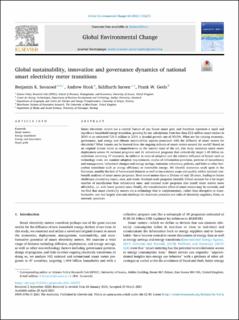| dc.description.abstract | Smart electricity meters are a central feature of any future smart grid, and therefore represent a rapid and significant household energy transition, growing by our calculations from less than 23.5 million smart meters in 2010 to an estimated 729.1 million in 2019, a decadal growth rate of 3013%. What are the varying economic, governance, and energy and climate sustainability aspects associated with the diffusion of smart meters for electricity? What lessons can be learned from the ongoing rollouts of smart meters around the world? Based on an original dataset twice as comprehensive as the current state of the art, this study examines smart meter deployment across 41 national programs and 61 subnational programs that collectively target 1.49 billion installations involving 47 countries. In addition to rates of adoption and the relative influence of factors such as technology costs, we examine adoption requirements, modes of information provision, patterns of incumbency and management, behavioral changes and energy savings, emissions reductions, policies, and links to other low-carbon transitions such as energy efficiency or renewable energy. We identify numerous weak spots in the literature, notably the lack of harmonized datasets as well as inconsistent scope and quality within national cost-benefit analyses of smart meter programs. Most smart meters have a lifetime of only 20 years, leading to future challenges concerning repair, care, and waste. National-scale programs (notably China) account for a far larger number of installations than subnational ones, and national scale programs also install smart meters more affordably, i.e. with lower general costs. Finally, the transformative effect of smart meters may be oversold, and we find that smart electricity meters are a technology that is complementary, rather than disruptive or transformative, one that largely does not challenge the dominant practices and roles of electricity suppliers, firms, or network operators. | en_US |

